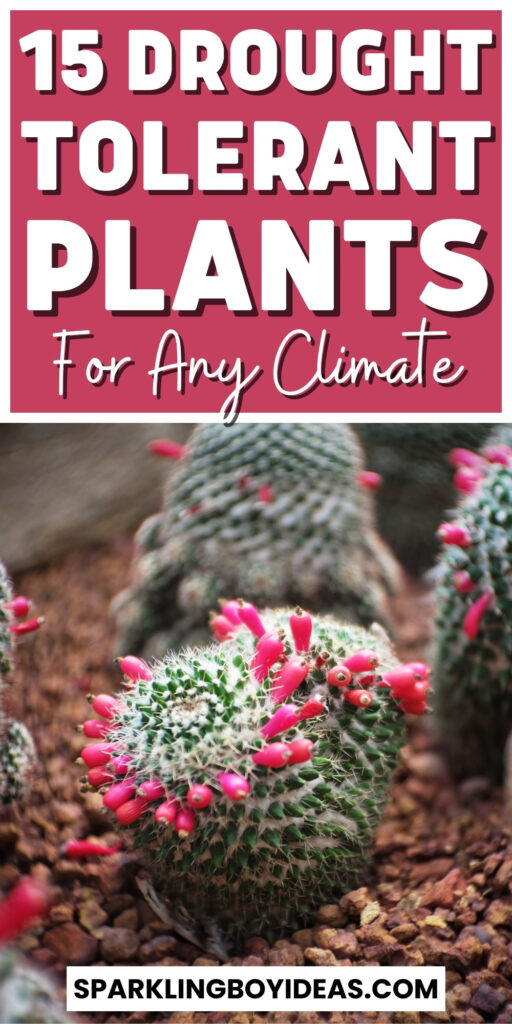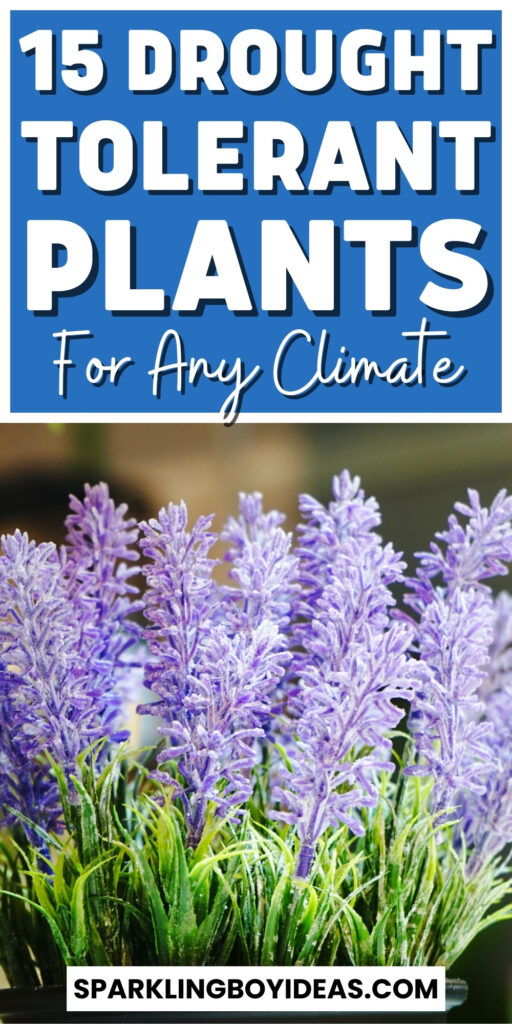Create a stunning garden oasis with drought tolerant plants! Explore our top picks for low-maintenance and water-saving options that thrive in any climate.

As a plant enthusiast, I’ve always loved surrounding myself with greenery and blooms.
But when I moved to an area with a hot, arid climate, I quickly realized that my gardening habits needed to adapt.
Water conservation became a top priority, and I began seeking out drought-tolerant plants that could thrive in this challenging environment.
Drought-tolerant plants are those that can survive with minimal watering and still look beautiful.
These plants are perfect for areas with water shortages, hot climates, or anyone looking to conserve water.
Not only do they save on water usage, but they also require less maintenance, making them ideal for busy gardeners.
In this blog post, I’ll be sharing my personal experiences with drought-tolerant plants and the varieties that have flourished in my garden.
From succulents to native grasses to colorful wildflowers, there are endless options for creating a stunning, water-wise landscape.
Whether you’re looking to reduce your water bill, conserve resources, or simply add some low-maintenance beauty to your yard, I hope that my insights and tips will inspire you to explore the world of drought-tolerant plants.
So let’s dive in and discover the beauty of water-wise gardening!
Understanding Drought Tolerant Plants
Drought tolerance refers to a plant’s ability to survive and grow in environments with limited water availability.
These plants have developed various mechanisms to adapt to dry conditions, such as deep root systems, succulent leaves, or waxy coatings that reduce water loss through evaporation.
They can store water in their tissues, enabling them to endure prolonged periods without rainfall.
Benefits of Drought Tolerant Plants
1. Water Conservation: Drought-tolerant plants significantly reduce water usage in landscapes, helping to conserve this precious resource.
2. Low Maintenance: These plants require less watering and are generally more resistant to pests and diseases, reducing the need for chemical treatments.
3. Cost Savings: By reducing water consumption and maintenance requirements, drought-tolerant plants can save you money on your water bills and garden upkeep.
4. Environmental Resilience: Planting drought-tolerant species promotes ecological balance and helps mitigate the impact of drought on local ecosystems.
Factors to Consider when Choosing Drought Tolerant Plants
When selecting drought-tolerant plants for your garden, there are a few factors to keep in mind:
1. Climate: Consider the climate of your region and choose plants that are well-suited to the local conditions.
Some drought-tolerant plants thrive in hot and arid climates, while others can withstand cooler and drier environments.
2. Soil Type: Different plants have specific soil requirements. Ensure that the soil in your garden is well-draining to prevent waterlogging and root rot.
If you have sandy or clay soil, consider amending it with organic matter to improve its texture and drainage.
3. Sunlight Exposure: Most drought-tolerant plants thrive in full sun.
Assess the amount of sunlight your garden receives throughout the day and select plants accordingly.
Some varieties can tolerate partial shade, but they may not be as drought resistant as those that prefer full sun.
4. Watering Needs: Although drought-tolerant plants can withstand dry conditions, they still require regular watering during the establishment period.
Once they are established, they will require less water, but it’s essential to provide occasional deep watering to promote healthy root growth.
By incorporating drought-tolerant plants into your garden, you can create a stunning landscape that requires less water and maintenance.
15 Drought Tolerant Plants You’ll Love
Now let’s explore 15 wonderful drought-tolerant plants that will add beauty and resilience to your garden:
1. Agave (Agave spp.)
Agave is a group of succulent plants known for their striking rosette-shaped leaves and impressive architectural appeal.
These plants can thrive in arid environments and require minimal water once established.
Their unique shapes and sizes make them excellent focal points in xeriscapes and rock gardens.
2. Lavender (Lavandula spp.)
Lavender is a versatile and aromatic herb that flourishes in dry and sunny conditions.
Its fragrant purple flowers attract pollinators while its gray-green foliage adds texture and color to the landscape.
Lavender is known for its calming scent and can be used in various culinary and therapeutic applications.
3. Sedum (Sedum spp.)
Sedums, also known as stonecrops, are a diverse group of succulent plants that thrive in dry and rocky environments.
They come in a wide range of shapes, sizes, and colors, making them a popular choice for rock gardens and containers.
Sedums are low-maintenance and can tolerate poor soil conditions.
4. Yarrow (Achillea spp.)
Yarrow is a hardy perennial with fern-like foliage and clusters of small, colorful flowers.
It is highly drought-tolerant and can adapt to a variety of soil types.
Yarrow attracts butterflies and beneficial insects, making it a valuable addition to pollinator gardens.
5. Russian Sage (Perovskia atriplicifolia)
Russian Sage is a tall and airy perennial with aromatic gray-green foliage and lavender-blue flowers.
It thrives in full sun and well-drained soil, making it an ideal choice for dry gardens.
Russian Sage adds a touch of elegance and vertical interest to any landscape.
6. California Poppy (Eschscholzia californica)
The California Poppy is a vibrant wildflower native to the western United States.
Its delicate orange or yellow flowers bloom profusely in the sun and close during cloudy or cool weather.
California Poppies are well-adapted to dry conditions and are easy to grow from seed.
7. Coneflower (Echinacea spp.)
Coneflowers are perennial plants known for their daisy-like flowers with prominent, cone-shaped centers.
They come in various colors, including purple, pink, and white.
Coneflowers are not only drought-tolerant but also attract bees and butterflies to the garden.
Their long-lasting blooms make them a beautiful addition to borders and flower beds.
8. Blanket Flower (Gaillardia spp.)
The blanket Flower is a colorful perennial that thrives in hot and dry conditions.
Its vibrant red, yellow, and orange flowers resemble a colorful blanket, hence the name.
Blanket Flowers are easy to grow and can tolerate poor soil conditions.
They are excellent for attracting pollinators and adding a pop of color to your garden.
9. Red Hot Poker (Kniphofia spp.)
Red Hot Poker, also known as Torch Lily, is a striking perennial with tall flower spikes in vibrant shades of red, orange, and yellow.
It is well-adapted to dry conditions and attracts hummingbirds and butterflies.
Red Hot Pokers make a bold statement in garden borders and are a favorite among gardeners seeking vibrant, drought-tolerant plants.
10. Kangaroo Paw (Anigozanthos spp.)
Kangaroo Paw is a unique and eye-catching plant native to Australia.
Its flowers resemble the paws of kangaroos, hence the name.
The plant features long, slender leaves and tall flower stalks with fuzzy, tubular flowers in shades of red, yellow, and green.
Kangaroo Paws are drought-tolerant and thrive in well-drained soil and full sun.
They add a touch of exotic beauty to gardens and make excellent-cut flowers.
11. Blue Fescue (Festuca glauca)
Blue Fescue is a compact ornamental grass with fine, silvery-blue foliage.
It forms neat clumps and is well-suited for borders, rock gardens, or as a ground cover.
Blue Fescue is highly drought-tolerant and requires minimal maintenance.
Its unique texture and color provide a cool and calming effect in the garden.
12. Lamb’s Ear (Stachys byzantina)
Lamb’s Ear is a perennial herb cherished for its soft, fuzzy leaves that resemble a lamb’s ear.
This drought-tolerant plant thrives in dry conditions and prefers well-drained soil.
Lamb’s Ear produces spikes of small, pink, or purple flowers, adding a delicate touch to borders and containers.
It’s velvety foliage and low-growing habit make it a popular choice for edging pathways.
13. Black-eyed Susan (Rudbeckia spp.)
Black-eyed Susan is a cheerful wildflower with bright yellow or orange petals and a dark center.
It is a tough and reliable perennial that can withstand hot and dry conditions.
Black-eyed Susans attract bees and butterflies and are perfect for naturalizing meadows and adding a burst of color to cottage-style gardens.
14. Mexican Feather Grass (Nassella tenuissima)
Mexican Feather Grass is a delicate ornamental grass known for its feathery, fine-textured foliage.
It forms graceful clumps and sways gently in the breeze, adding movement and visual interest to the garden.
Mexican Feather Grass is highly drought-tolerant and thrives in well-drained soil.
Its ethereal appearance makes it a popular choice for mass plantings or as a focal point in rock gardens.
15. Purple Coneflower (Echinacea purpurea)
Purple Coneflower is a perennial favorite known for its distinctive purple petals and prominent cone-shaped center.
It is not only drought-tolerant but also a powerful medicinal plant with immune-boosting properties.
Purple Coneflower attracts bees, butterflies, and birds to the garden, making it a valuable addition to pollinator-friendly landscapes.
Tips for Successfully Growing Drought Tolerant Plants
1. Proper Watering: While drought-tolerant plants can survive with minimal water, it’s crucial to provide adequate irrigation during their establishment phase. Once established, water deeply but infrequently to encourage deep root growth.
2. Mulching: Apply a layer of organic mulch around your drought-tolerant plants to retain moisture in the soil, reduce weed growth, and regulate soil temperature.
3. Soil Preparation: Improve the soil’s drainage by adding organic matter, such as compost or well-rotted manure. This enhances the soil’s water-holding capacity and promotes healthy root development.
4. Grouping Plants: Grouping drought-tolerant plants with similar water needs together can create microclimates and conserve water. This helps ensure that each plant receives the appropriate amount of moisture.
5. Pruning and Deadheading: Regularly prune and deadhead your plants to encourage new growth and prolong blooming. This also helps divert energy to essential parts of the plant during dry periods.
6. Choosing Native Plants: Consider incorporating native drought-tolerant plants into your garden. They are adapted to the local climate and often require minimal maintenance once established.
FAQs
Q. How often do drought-tolerant plants need watering?
Drought-tolerant plants require less frequent watering once established. Water deeply but infrequently, allowing the soil to dry out between watering sessions.
Q. Can drought-tolerant plants survive in all climates?
While most drought-tolerant plants are adapted to arid or semi-arid regions, there are varieties suited for different climates. Choose plants that are well-suited to your specific climate and growing conditions.
Q. Do drought-tolerant plants require special soil conditions?
Drought-tolerant plants generally thrive in well-draining soil. It’s beneficial to amend the soil with organic matter to improve its texture and water-holding capacity.
Q. Can I grow drought-tolerant plants in containers?
Yes, many drought-tolerant plants can be grown in containers. Ensure the containers have drainage holes, use well-draining soil, and water the plants appropriately.
Q. Are drought-tolerant plants low maintenance?
Drought-tolerant plants are generally low maintenance once established. However, they still require occasional watering, pruning, and maintenance to ensure their health and longevity.


Conclusion
In conclusion, cultivating a garden with drought-tolerant plants not only reduces water consumption but also adds beauty and resilience to your outdoor space.
By carefully selecting from the 15 plants mentioned above and following the tips provided, you can create a sustainable and visually appealing landscape that thrives even in dry conditions.





